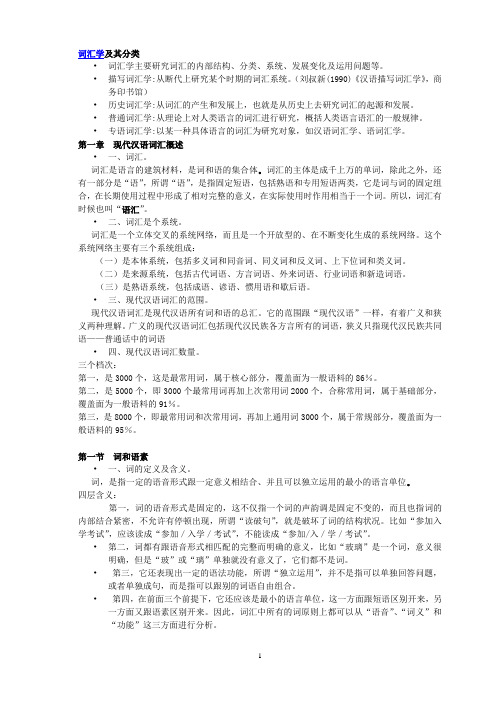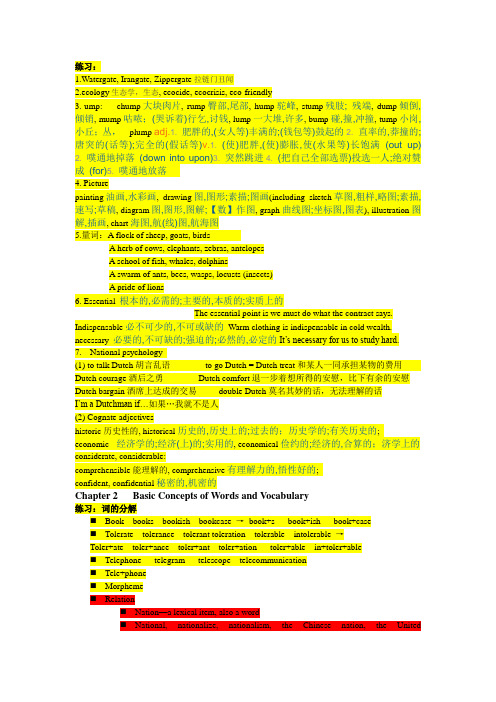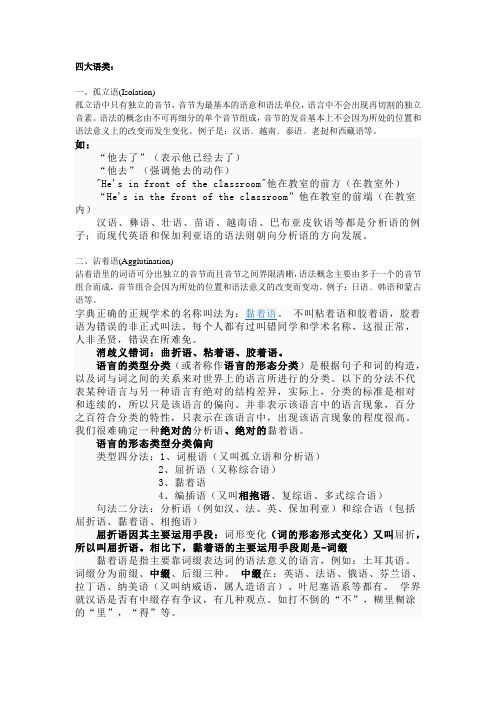词汇学资料
- 格式:docx
- 大小:16.27 KB
- 文档页数:5

词汇学及其分类•词汇学主要研究词汇的内部结构、分类、系统、发展变化及运用问题等。
•描写词汇学:从断代上研究某个时期的词汇系统。
(刘叔新(1990)《汉语描写词汇学》,商务印书馆)•历史词汇学:从词汇的产生和发展上,也就是从历史上去研究词汇的起源和发展。
•普通词汇学:从理论上对人类语言的词汇进行研究,概括人类语言语汇的一般规律。
•专语词汇学:以某一种具体语言的词汇为研究对象,如汉语词汇学、语词汇学。
第一章现代汉语词汇概述•一、词汇。
词汇是语言的建筑材料,是词和语的集合体。
词汇的主体是成千上万的单词,除此之外,还有一部分是“语”,所谓“语”,是指固定短语,包括熟语和专用短语两类,它是词与词的固定组合,在长期使用过程中形成了相对完整的意义,在实际使用时作用相当于一个词。
所以,词汇有时候也叫“语汇”。
•二、词汇是个系统。
词汇是一个立体交叉的系统网络,而且是一个开放型的、在不断变化生成的系统网络。
这个系统网络主要有三个系统组成:(一)是本体系统,包括多义词和同音词、同义词和反义词、上下位词和类义词。
(二)是来源系统,包括古代词语、方言词语、外来词语、行业词语和新造词语。
(三)是熟语系统,包括成语、谚语、惯用语和歇后语。
•三、现代汉语词汇的范围。
现代汉语词汇是现代汉语所有词和语的总汇。
它的范围跟“现代汉语”一样,有着广义和狭义两种理解。
广义的现代汉语词汇包括现代汉民族各方言所有的词语,狭义只指现代汉民族共同语——普通话中的词语•四、现代汉语词汇数量。
三个档次:第一,是3000个,这是最常用词,属于核心部分,覆盖面为一般语料的86%。
第二,是5000个,即3000个最常用词再加上次常用词2000个,合称常用词,属于基础部分,覆盖面为一般语料的91%。
第三,是8000个,即最常用词和次常用词,再加上通用词3000个,属于常规部分,覆盖面为一般语料的95%。
第一节词和语素•一、词的定义及含义。
词,是指一定的语音形式跟一定意义相结合、并且可以独立运用的最小的语言单位。

练习:1.Watergate, Irangate, Zippergate拉链门丑闻2.ecology生态学,生态, ecocide, ecocrisis, eco-friendly3.-ump: chump大块肉片, rump臀部,尾部, hump驼峰, stump残肢; 残端, dump倾倒,倾销, mump咕哝;(哭诉着)行乞,讨钱, lump一大堆,许多, bump碰,撞,冲撞, tump小岗,小丘;丛,plump adj.1. 肥胖的,(女人等)丰满的;(钱包等)鼓起的2. 直率的,莽撞的;唐突的(话等);完全的(假话等)v.1. (使)肥胖,(使)膨胀,使(水果等)长饱满(out up) 2. 噗通地掉落(down into upon)3. 突然跳进4. (把自己全部选票)投选一人;绝对赞成(for)5. 噗通地放落4. Picturepainting油画,水彩画, drawing图,图形;素描;图画(including sketch草图,粗样,略图;素描,速写;草稿, diagram图,图形,图解;【数】作图, graph曲线图;坐标图,图表), illustration图解,插画, chart海图,航(线)图,航海图5.量词:A flock of sheep, goats, birdsA herb of cows, elephants, zebras, antelopesA school of fish, whales, dolphinsA swarm of ants, bees, wasps, locusts (insects)A pride of lions6. Essential根本的,必需的;主要的,本质的;实质上的The essential point is we must do what the contract says. Indispensable必不可少的,不可或缺的Warm clothing is indispensable in cold wealth. necessary必要的,不可缺的;强迫的;必然的,必定的It’s necessary for us to study hard.7.National psychology(1) to talk Dutch胡言乱语to go Dutch = Dutch treat和某人一同承担某物的费用Dutch courage酒后之勇Dutch comfort退一步着想所得的安慰,比下有余的安慰Dutch bargain酒席上达成的交易double Dutch莫名其妙的话,无法理解的话I’m a Dutchman if…如果…我就不是人(2) Cognate adjectiveshistoric历史性的, historical历史的,历史上的;过去的;历史学的;有关历史的; economic经济学的;经济(上)的;实用的, economical俭约的;经济的,合算的;济学上的considerate, considerable:comprehensible能理解的, comprehensive有理解力的,悟性好的;confident, confidential秘密的,机密的Chapter 2 Basic Concepts of Words and Vocabulary练习:词的分解⏹Book books bookish bookcase →book+s book+ish book+case⏹Tolerate tolerance tolerant toleration tolerable intolerable →Toler+ate toler+ance toler+ant toler+ation toler+able in+toler+able⏹Telephone telegram telescope telecommunication⏹Tele+phone⏹Morpheme⏹Relation⏹Nation—a lexical item, also a word⏹National, nationalize, nationalism, the Chinese nation, the Unitednations—words and word equivalentsAll the words and word equivalents constitute the vocabulary of a language.2.3 Sound and Meaning对sound and meaning之间的联系的两种观点:1.The naturalists:a natural connection between sound and meaning. (自然的)2.The Conventionalists:the relations are conventional and arbitrary(约定俗成的,随意的).证据:The meaning of a word is a kind of linguistic social contract.Words that convey the same meaning have different phonological forms in different languages. the same phonological forms may convey different meanings; e.g.: sight, site, cite.2.4 Meaning and Concept1. Relation⏹Meaning is closely related to a concept.⏹ A concept is the base of the meaning of a word.⏹ A word is used to label a concept.⏹概念从对对象中提炼,词汇通过概念表现对象。

四大语类:一、孤立语(Isolation)孤立语中只有独立的音节,音节为最基本的语意和语法单位,语言中不会出现再切割的独立音素。
语法的概念由不可再细分的单个音节组成,音节的发音基本上不会因为所处的位置和语法意义上的改变而发生变化。
例子是:汉语﹑越南﹑泰语﹑老挝和西藏语等。
如:“他去了”(表示他已经去了)“他去”(强调他去的动作)"He's in front of the classroom"他在教室的前方(在教室外)“He's in the front of the classroom”他在教室的前端(在教室内)汉语、彝语、壮语、苗语、越南语、巴布亚皮钦语等都是分析语的例子;而现代英语和保加利亚语的语法则朝向分析语的方向发展。
二、沾着语(Agglutination)沾着语里的词语可分出独立的音节而且音节之间界限清晰,语法概念主要由多于一个的音节组合而成,音节组合会因为所处的位置和语法意义的改变而变动。
例子:日语﹑韩语和蒙古语等。
字典正确的正规学术的名称叫法为:黏着语。
不叫粘着语和胶着语,胶着语为错误的非正式叫法。
每个人都有过叫错同学和学术名称,这很正常,人非圣贤,错误在所难免。
消歧义错词:曲折语、粘着语、胶着语。
语言的类型分类(或者称作语言的形态分类)是根据句子和词的构造,以及词与词之间的关系来对世界上的语言所进行的分类。
以下的分法不代表某种语言与另一种语言有绝对的结构差异,实际上,分类的标准是相对和连续的,所以只是该语言的偏向。
并非表示该语言中的语言现象,百分之百符合分类的特性,只表示在该语言中,出现该语言现象的程度很高。
我们很难确定一种绝对的分析语、绝对的黏着语。
语言的形态类型分类偏向类型四分法:1、词根语(又叫孤立语和分析语)2、屈折语(又称综合语)3、黏着语4、编插语(又叫相抱语、复综语、多式综合语)句法二分法:分析语(例如汉、法、英、保加利亚)和综合语(包括屈折语、黏着语、相抱语)屈折语因其主要运用手段:词形变化(词的形态形式变化)又叫屈折,所以叫屈折语。

词汇学复习资料词汇学复习资料词汇学是语言学的一个重要分支,研究词汇的构成、分类和使用规律。
对于学习一门语言来说,掌握丰富的词汇是非常重要的。
在这篇文章中,我们将提供一些词汇学的复习资料,帮助读者巩固和扩展词汇量。
一、词汇的构成词汇是语言的基本单位,是由一个或多个音素组成的。
在不同的语言中,词汇的构成方式也有所不同。
例如,英语中的词汇主要由字母组成,而汉语中的词汇则由汉字组成。
1. 字母构词法英语中的词汇通常由字母组成,可以通过添加前缀、后缀和词根来构成新的词汇。
例如,单词“unhappiness”由前缀“un-”(表示否定)和词根“happy”组成。
2. 字形构词法汉语中的词汇由汉字组成,可以通过添加偏旁部首、衍生字和合成字来构成新的词汇。
例如,汉字“学”可以通过添加偏旁部首“子”来构成“字”,表示学习。
二、词汇的分类词汇可以按照不同的分类标准进行分类,例如按照词性、语义和用途等。
下面是一些常见的词汇分类。
1. 词性分类词汇可以分为名词、动词、形容词、副词、代词、介词、连词和感叹词等不同的词性。
名词用来表示人、事物或概念,动词用来表示动作或状态,形容词用来描述人或事物的特征,副词用来修饰动词、形容词或其他副词,代词用来代替名词,介词用来表示位置、时间或方式,连词用来连接词语或句子,感叹词用来表示强烈的情感。
2. 语义分类词汇可以按照词义的相似性进行分类。
例如,可以将名词按照人、动物、植物、物体、抽象概念等进行分类;将动词按照行为、状态、感觉、思维等进行分类;将形容词按照颜色、大小、形状、性质等进行分类。
3. 用途分类词汇可以按照在句子中的作用进行分类。
例如,可以将词汇分为实词和虚词。
实词包括名词、动词、形容词和副词,它们在句子中起到实际的意义;虚词包括代词、介词、连词和感叹词,它们在句子中起到连接或修饰的作用。
三、词汇的使用规律词汇的使用规律是指在特定语境中使用词汇的约束条件。
不同的语言和不同的语境中,词汇的使用规律也有所不同。

论述题一、一般词汇与基本词汇的关系基本词汇和一般词汇都有各自特点,因此,它们是语言词汇中两个完全不同的部分。
但是,基本词汇和一般词汇又有非常密切的联系,它们相互依存,共同发展,都是语言词汇中不可缺少的部分。
第一,基本词汇是语言的基础,它也是一般词汇形成的基础,一般词汇中的大多数词都是在基本词汇基础上形成的。
第二,一般词汇反映社会的发展是非常敏感的,它几乎经常存在不吨的变动之中,因此,语言词汇中的新成分往往首先出现在一般词汇中,然后个别成分再进入基本词汇中,促成基本词汇的发展。
从这一角度讲,一般词汇又可以充当基本词汇发展的源泉。
第三,基本词汇和一般词汇中的个别成分又是可以互相转换,在词汇发展的过程中,随着社会交际需要的改变,某些基本词转化成一般词,而某些一般词也能转化为基本词汇,如过去的基本词“鬼、窝窝头”等,现在已成了一般词,又如过去的一般词“党”,现在已经由一般词转化成基本词,成为“共产党”的简称。
总之,基本词汇和一般词汇就是在这样相互依存不断转化的关系中间共同发展和丰富起来。
它们的发展又形成整个词汇的形成。
二、词义发展的概况1、新词的增加。
语言是随着社会的发展而发展的,在这发展过程当中,词汇又是最敏感的部分,因此,社会上的一切都会在词汇中有所反映,这就促成了语言中新词的不断增加。
2、双音词的增多。
随着汉语的发展,词汇中的双音词逐渐增多起来,由单音向双音发展,是汉语词汇发展的一种必然现象。
因为随着社会的发展,交际的需求越来越纷繁复杂,需要表示的事物越来越多,有限的单音节形式就必然造成语言中同音词的大量出现。
因而给人们的交际带来许多不便,汉语词的双音化就此发展起来。
3、实词虚化现象的发展。
主要表现在两个方面:一方面是由实词类变为虚词类,如“因”原为“原因”,而后发展为“因为”,充当连词使用;另一方面,是由可以充当词根词素的实词虚化成了附加词素,如“了”原为“了结”虚化成了“好了”。
“了结”是实词,后来虚化成了词尾词素,读为“le”附在动词后面,表示完成体的语法意义,如“看了”、“做了”。

词汇学知识点词汇学是语言学的一个重要分支,研究词汇的形态、构词法、含义、语法功能和使用规律等方面的知识。
词汇学知识点有助于我们更深入地了解语言的结构和规律,提高我们的语言运用能力和沟通能力。
下面将就词汇学的一些重要知识点进行详细介绍。
1. 词汇的分类根据词性的不同,词汇可以分为名词、动词、形容词、副词、代词、介词、连词和感叹词等不同种类。
名词是表示人、事、物、地点或抽象概念的词,如“学校”、“朋友”;动词是表示动作或状态的词,如“看”、“跑”;形容词是用来描述名词或代词的性质或特征的词,如“美丽”、“聪明”;副词是用来修饰动词、形容词或其他副词的词,如“很”、“非常”。
2. 词汇的构词法构词法是指词汇的构成规律和方法。
词汇可以通过加前缀、后缀、派生、复合、缩略、转化等方式形成新词。
比如,“美”+“丽”=“美丽”;“快”+“速”=“快速”;“快速”+“度”=“快速度”。
3. 词汇的含义词汇的含义是指词汇所代表的概念或事物。
词汇的含义可以根据词义的延伸、转义、比喻、象征等方式进行词义推论。
比如,“明星”原指天空中的星星,后引申为受人尊敬或崇拜的人。
4. 词汇的语法功能词汇在句子中具有不同的语法功能,如名词可以作主语、宾语、定语、表语等;动词可以表示主谓关系、宾语关系、状语关系等;形容词和副词可以修饰名词或代词等。
5. 词汇的使用规律词汇在语言运用中有一定的使用规律,比如词的搭配、语法环境、语言风格等。
正确地运用词汇有助于提高语言表达的准确性和丰富性。
通过以上对词汇学知识点的介绍,我们可以更系统地了解词汇在语言中的作用和重要性,进一步提高我们的语言水平和表达能力。
希望大家都能在学习词汇学知识点的过程中取得更好的成绩,展现自己在语言运用方面的能力。
【正文结束】。
词汇学知识点总结词汇学是语言学的一个重要分支,研究的是词汇的形成、结构和意义等方面的问题。
在学习英语等外语的过程中,词汇是其中一个重要的组成部分。
下面,本文将对词汇学的一些知识点进行总结与归纳。
一、词的形态学词的形态学是词汇学中必须掌握的一个重要方面,主要包括词的构词法、屈折变化和派生变化等。
词的构词法指的是如何通过组合原有的词来创造新词,包括派生法、合成法、缩略法、转化法等。
屈折变化指根据语法要求,变化词的形态以表示不同的格、时、数、性等。
派生变化则指通过在原有词基础上添加字母或词缀等来产生新的词。
掌握词的形态学是很有必要的,因为它和词汇的理解和使用密切相关。
二、词的分类在英语中,词可以根据其不同的语法特征被归为不同的类别,常见的类别包括名词、代词、动词、形容词、副词、介词、连词和感叹词等。
不同的词在句子中扮演着不同的角色,掌握各类别之间的区别以及它们在句子中的作用,可以帮助我们更好地理解和表达语言。
三、词义词义是从语言学的角度定义词的意义,包括原义和引申义。
原义指的是一个词最基本的意思,而引申义则是在原义基础上经过延伸、扩展而得到的新意义。
同一个词的不同意义和语言环境等也会导致其含义的变化,例如“bank”既可以表示银行,也可以表示河岸等。
在学习外语的过程中,掌握词义是十分重要的。
四、词汇的学习方法词汇的学习是英语学习中最基础也最重要的部分之一,因此选择适合自己的学习方法对于提高词汇量、扩大词汇面积至关重要。
常用的学习方法包括反复背诵、积累单词簿、整理词根词缀、阅读和听力等。
在学习方法上,以选择适合自己和有用的方法为主,同时注意与语言运用的联系,不断地推广和实践。
五、词汇的应用掌握了词汇学的知识和学习方法后,其实就迈出了学习英语的第一步。
在实际运用中,如何运用得当也是至关重要的环节。
为了提高语言的流利度,需要在口语和书面语两个方面加强实践,增强实际运用能力。
另外,可以较晚多在社交网络等平台上与外国人联系,使用所学的词汇,将知识应用到实际交流之中,效果更佳。
词汇学知识点总结词汇学是研究词汇的学科,它是语言学的一个重要分支,涉及了语言的构成、变化和使用等方面。
词汇学对于语言的理解和应用具有重要的意义,它不仅可以帮助我们更好地掌握语言知识,还可以帮助我们提高语言运用能力。
在这篇文章中,我们将对词汇学的知识点进行总结,帮助读者更好地理解和掌握这一学科。
一、词的定义和分类词是语言中的最小意义单位,是构成句子和表达意思的基本单位。
按照在句子中的功能和语法特征,词可以分为实词和虚词两大类。
实词包括名词、动词、形容词、副词等,它们能够表示具体的事物或抽象的概念;虚词包括代词、连词、介词、助词等,它们通常用来连接或修饰实词,没有明确的词义。
二、词汇的构成词汇的构成是指词的组成方式和形态特征。
在词汇的构成中,我们可以看到一些常见的构词法,如前缀、后缀、派生、合成、转化等。
通过这些构词法,我们可以对词汇进行灵活组合和创造,丰富语言的表达能力。
1.前缀前缀是指加在词根前面的一个字,可以改变词的词义或语法特征。
比如,“un-”表示否定,“re-”表示再次,“pre-”表示在前面等。
2.后缀后缀是指加在词根后面的一个字,同样可以改变词的词义或语法特征。
比如,“-ing”表示进行时,“-ful”表示充满的意思,“-ment”表示名词化等。
3.派生派生是指通过词根和词缀的组合来创造和衍生新的词。
比如,“happy”是一个形容词,通过加上“-ness”后缀就可以派生出名词“happiness”。
4.合成合成是指两个或多个词汇组合在一起,形成一个新的词。
比如,“blackboard”由“black”和“board”两个实词组合而成。
5.转化转化是指一个词汇的词类发生改变,但词形不变。
比如,“work”可以作为动词,也可以作为名词,它的词形都不发生变化。
词汇的构成方式是多种多样的,通过学习这些构词法,我们可以更好地理解和掌握词汇的形态特征,有助于提高我们的语言表达能力。
三、词汇的语义特征语义是指词汇所携带的意义,它是语言交流和理解的基础。
现代英语词汇学一、词汇的构成(Word - formation)1. 词根(Root)- 定义:词根是单词的核心部分,它包含着单词的基本意义。
例如,“vis”在“visible”(可见的)、“vision”(视觉)和“visit”(参观)中是词根,其基本意义与“看”有关。
读音:[ruːt],词性:名词。
2. 前缀(Prefix)- 定义:加在词根前面,改变单词的意义。
例如,“un - ”在“unhappy”(不快乐的)中表示否定。
读音:[ˈpriːfɪks],词性:名词。
- 常见前缀及其意义:- “re - ”(再,又),如“rewrite”(重写)。
读音:[riː - ],词性:前缀。
- “pre - ”(在……之前),如“preview”(预习,预演)。
读音:[priː - ],词性:前缀。
3. 后缀(Suffix)- 定义:加在词根后面,改变单词的词性或意义。
例如,“ - er”在“worker”(工人)中表示“做……的人”。
读音:[ˈsʌfɪks],词性:名词。
- 常见后缀及其作用:- “ - ness”(构成名词,表示性质、状态),如“happiness”(幸福)。
读音:[nəs],词性:后缀。
- “ - ful”(构成形容词,表示充满……的),如“helpful”(有帮助的)。
读音:[fʊl],词性:后缀。
二、词性(Parts of Speech)1. 名词(Noun)- 定义:表示人、事物、地点、抽象概念等。
例如,“book”(书)、“city”(城市)、“love”(爱)。
读音:[naʊn],词性:名词。
- 名词的分类:- 可数名词(Countable Noun),如“apple”(苹果),有单复数形式。
- 不可数名词(Uncountable Noun),如“water”(水),一般没有复数形式。
2. 动词(Verb)- 定义:表示动作或状态。
例如,“run”(跑)、“be”(是)。
词汇学知识点范文词汇学是语言学的一个重要分支,研究词汇的形成、构成、分类和使用规律等方面的知识。
在词汇学中,有一些重要的知识点,包括词汇的定义、词汇的分类、词汇的构词和语义。
首先,词汇的定义是指语言中的最小语义单位,它可以独立存在,具有其中一种特定的意义。
词汇可以是单个词,如“apple”(苹果),也可以是由多个单词组成的词组或短语,如“break up”(分手)。
词汇的定义有助于我们了解词汇在语言中的作用和重要性。
其次,词汇可以按照不同的分类标准进行分类。
按照词性分类,词汇可以分为名词、动词、形容词、副词等。
按照语法关系分类,词汇可以分为实义词和虚词。
实义词是指有具体意义的词,如名词或动词,而虚词是指没有具体意义,用于构成句子结构的词,如冠词、连词和介词等。
词汇的构词是指通过加缀或组合多个词语来构成新的词汇。
构词有助于丰富词汇的表达能力和多样性。
例如,通过加前缀“un-”可以构成反义词,“happy”(快乐)变为“unhappy”(不快乐);通过加后缀“-ness”可以构成名词,“sad”(悲伤)变为“sadness”(悲伤)。
词汇的语义是指词汇所传达的意义和信息。
词汇的语义可以通过上下文和语境来理解和解释。
词汇的意义可以是字面意义,也可以是隐喻意义或引申意义。
例如,“rain”(雨)的字面意义是指天空中的水滴,但在诗歌中,它可能代表着忧伤或洗刷罪恶。
总的来说,词汇学是一门研究词汇的学科,包括了词汇的定义、分类、构词和语义等知识点。
了解这些知识点有助于我们更好地理解和运用词汇,提高语言表达的能力。
练习:I. Watergate, Iran gate, Zipp ergate 拉链门丑闻2.ecology 生态学,生态,ecocide, ecocrisis, eco-friendly3. -ump: chump 大块肉片,rump 臀部,尾部,hump 驼峰,stump 残肢;残端,dump 倾倒, 倾销,mump 咕哝;(哭诉着)行乞,讨钱,lump 一大堆,许多,bump 碰,撞冲撞,tump 小岗, 小丘;丛,plump adj.1.肥胖的,(女人等)丰满的;(钱包等)鼓起的2.直率的,莽撞的; 唐突的(话等);完全的(假话等)v.l.(使)肥胖,(使)膨胀,使(水果等)长饱满(out up )2.噗通地掉落(down into upon )3.突然跳进4.(把自己全部选票)投选一人;绝对赞 成(for )5.噗通地放落4. Picturepainting 油画,水彩画,drawing 图,图形;素描图画(including sketch 草图,粗样,略图;素描, 速写;草稿,diagram 图周形,图解;【数】作图,graph 曲线图;坐标图周表),illustration 图 解,插画,chart 海图,航(线)图,航海图5. 量词: A flock of shee p, goats, birdsA herb of cows, ele phan ts, zebras, an tel opesA school of fish, whales, dolphinsA p ride of lio ns6. Essential 根本的,必需的;主要的,本质的;实质上的The esse ntial point is we must do what the con tract says.In dis pen sable 必不可少的,不可或缺的 Warm cloth ing is in dis pen sable in cold wealth. necessary 必要的,不可缺的;强迫的;必然的,必定的It ' s necessary for us to study hard.7. Nati onal psychologyto go Dutch = Dutch treat 和某人一同承担某物的费用 _Dutch courage 酒后之勇 Dutch comfort 退一步着想所得的安慰,比下有余的安慰Dutch bargain 酒席上达成的交易double Dutch 莫名其妙的话,无法理解的话 I ' m a Dutchman if 如果…我就不是人(2) Cogn ate adjectiveshistoric 历史性的,historical 历史的,历史上的;过去的;历史学的;有关历史的;__ economic 经济学的;经济(上)的;实用的,economical 俭约的;经济的,合算的;济学上的 con siderate, con siderable:comprehensible 能理解的,comprehensive 有理解力的,悟性好的; con fide nt, con fide ntial 秘密的,机密的Cha pter 2 Basic Conce pts of Words and Vocabulary练习:词的分解Book books bookish bookcase book+s book+ish book+caseTolerate tolera nee tolera nt tolerati on tolerable in tolerableToler+ate toler+a nee toler+a nttoler+ati on toler+able in+toler+able Tele phonetelegram telesc ope telecom mun icati onTele+phoneMorp heme Nati on — a lexical item, also a wordNati on al, n ati on alize, n ati on alism, the Chin ese n ati on, the Un ited hati ons — ⑴to talk Dutch 胡言乱语words and word equivale ntsAll the words and word equivale nts con stitute the vocabulary of a Ian guage.2.3Sou nd and Mea ning对sound and meaning之间的联系的两种观点:1.The naturalists : a natural connection between sound and meaning.(自然的)2.The Conventionalists : the relations are conventional and arbitrary(约定俗成的,随意的) 证据:The meaning of a word is a kind of lin guistic social con tract.Words that con vey the same meaning have differe nt phono logical forms in differe nt Ian guages. the same phono logical forms may con vey differe nt meanin gs; e.g.: sight, site, cite.2.4Meaning and Concept1. Relatio nMeaning is closely related to a concept.A concept is the base of the meaning of a word.A word is used to label a con cept.概念从对对象中提炼,词汇通过概念表现对象。
This approach to meaning can be diagrammed as : word <conceptQreferent(语词所指的对象)2.meaning 禾R concept 的不同点:(1) A concept is an abstraction from things of the same kind ,it refers to something in general, but not in p articular, while mea ning can refers to both someth ing in gen eral and in p articular.E: ①…some have begun to realize that the automobile is a mixed blessing.② The automobile was stalled in a sno wstorm.(2)Meaning in the Ian guage con text may have emoti onal and stylistic colors, exp ress one’ s emotion, attitude and position. Therefore, it adds supplementary value to the concept the word exp resses.E: ① dog might in clude the conno tati ons of friend, help er, loyalty, etc.② motherla nd, home, can dle, locust, pan da, etc.2.5 Classificatio n of Words1.By origi nNative wordsWords of An glo-Sax on origi n are n ative words. They form the great majority of the basicword stock of the English Ianguage. The basic word stock is the foun datio n of the vocabularyaccumulated over a nu mber of ep ochs. Most n ative words in moder n En glish are monosyllabic. Though small in nu mber, these words are the ones used most frequently in everydayspeech and writing; they p lay no small part in lin guistic p erforma nee and com muni cation.In the native stock we find the most frequently used words denoting the commonest thingsnecessary for life, such asnames of natural phenomena (sun, moon, rain, frost, snow …),names of animals and plants (horse, dog, tree, flower …),n ames of parts of body (head, hand, foot …),adjectives denoting size and color ( big, small, red, white …), verbs expressingconcrete actions (live, eat, work, go, come …) auxiliary and modal verbs, pronouns,most numerals, prepositions and conj unctions.The fundamental features of the basic word stockNational character: Words of the basic word stock denote the most common things andphenomena of the word. These words cannot be avoided by any speaker of a givencommunity, irrespective of class origin, education, profession, geographicalregions, culture, etc.Stability: as words in the basic word stock denote the commonest things necessary tolife, they are likely to remain unchanged.Productivity: Words of the basic word stock are mostly root words or monosyllabicwords. They are very active in forming new words. For example, the word hand formssuch derivatives and compounds as: handful, handy, handily, handbag, handball,handwriting , etc.Collocability: Basic words combine readily with other words to form habitualexpressions and phrases. The word hand again can be found in phrases like at firsthand, hand in hand, to show one s hand, to pla'yinto sb.s'hands, and so on.Loan wordsThe English vocabulary has replenished itself by continually taking over words from otherlanguages over the centuries. Those words borrowed from other languages are loan words orborrowed words. The historical development of the English language shows that English is aheavy borrower; it has adopted words from almost every known language, especially from Latin,French, and Greek. After World War II the English vocabulary expanded at a rate much fasterthan ever before.By level of usageCommon wordsCommon words are connected with the ordinary things or activities necessary to everyday life. The core of the common words is the basic word stock. They are stylistically neutral, hence they areappropriate in both formal and informal writing and speech.Literary wordsLiterary words are chiefly used in writing, especially in books written in a more elevated style, in official documents, or in formal speeches. They are comparatively seldom used in ordinaryconversation. In English, most of the literary words are of French, Latin or Greek origin. Many of them have their everyday synonyms. For example, cast (throw), edifice (building), endeavor (try), purchase (buy), etc.More examples: recognition, distinction, inclination, dubious, ameliorationColloquial wordsIn contrast with literary words, colloquial words or expressions are used mainly in spoken English, as in conversation among friends and colleagues. They can also be use in informal writings, but are inappropriate in formal speeches or writings. Theyare marked colloq. or in formal in diet ion aries. Such as: kid, guy, fellow, gay …Compare:Feeli ng fatigued, tom retired early. (literary)Tom felt so dog-tired he hit the sack early. (colloquial)Joh n was dismissed for p etty thievi ng. (com mon)Joh n was fired for p etty thievi ng. (colloquial)Pen alties for overdue books will be strictly en forced (literary)You have got to pay fines for overdue books.(colloquial)They approved of the plan, (literary)They agreed to the plan .(common)Slang wordsSlang wordsSlang is defined as Ianguage, words or phrases of a colorful, facetious (playfully jocular; humorous), or taboo n ature, inven ted for sp ecific occasi ons, or uses, or derived from the unconven tio nal use of the sta ndard vocabulary. The chief reas on for the formati on and use of sla ng expressi ons is to secure fresh ness and no velty. A sla ng usage is not gen erally used in formal con versati on uni ess the sp eakers are on in timate terms; sla ng embraces those dari ng and new exp ressi ons that have not bee n acce pted by the majority of people as Stan dard En glish.Sla ng wordsBeaver(girl)Smoky, bear (police)Nut, dome, upper, bea n, block (head)Elevated, merry, jolly, comfortable, boiled, tight, blue-eyed, stiff (dr unk)Tech ni cal wordsTech ni cal or sp ecial words refer to those words used in p articular disci pli nes and academic areas.They are also called terminologies or technical terms. Every branch of scienee, every profession or trade, every art and every sort of sports has its own technical terms. The function of those technical words is partly denote things or p rocesses which have no n ames in ordinary En glish, and p artly to in crease p recisi on in nomen clature.In music: symphony, son ata, orchestra, concerto.In educati on: audiovisual, microteach ingIn mathematics: algebra, geometry, calculus, trigo no metryIn biology: clone, embryo, cell , orga ni sm, DNA(deoxyrib on ucleic acid), geneMost of these tech ni cal terms are Lati n or Greek in origi n. In fact, they are part of literary words. Most of the tech ni cal words rema in esse ntially foreig n outsiders,even to educated n ative sp eakers. However, un der the in flue neeradio, television, newspaper and the Internet, we are witnessing a remarkable break ingdow n of the barrier betwee n tech ni cal and com mon words. Many tech ni cal n eologisms created yesterday by sp ecialists are today heard in ordinary con versati on, e.g. moon walk, space shutter, gene, tran sge nic, clone, etc.By no ti onFunction wordsFunction words are ofte n short words such as determ in ers, conj un cti ons.to to ofprep ositi ons, auxiliaries, and so forth. Although they do not have much of their lexical meaning, they have a special kind of meaning---grammatical meaning. They act as grammatical sig nals to show the connection betwee n content words. is that function words belong to a relatively small comparison to content words. The total number of They are stable; they do not come and go withCha nging fashi ons and ideas. Content wordsContent words have independent lexical meanin gs. Content words bel ong to an open list. New lexical items are constantly being created, and no one could make a comp lete list of all the content words in En glish. Another important characteristic and permanent set of words, in functional words is about 154.。